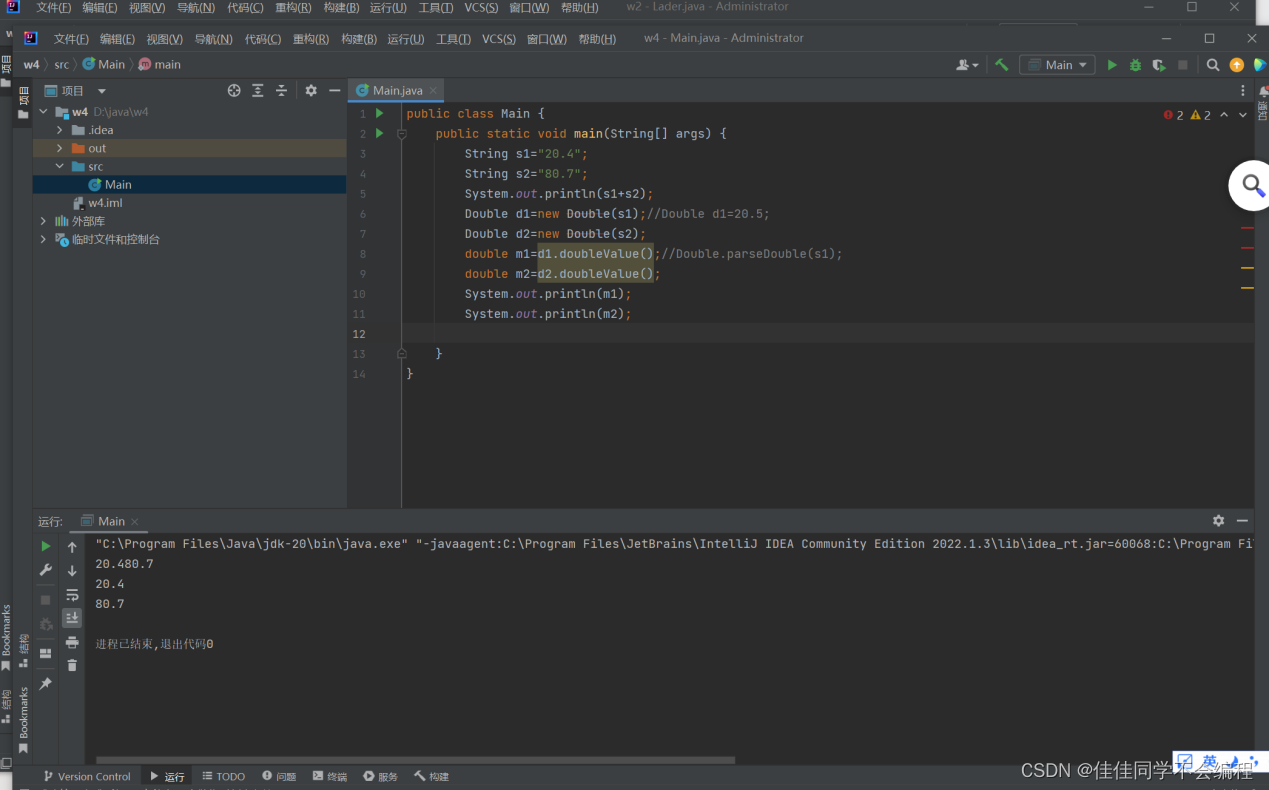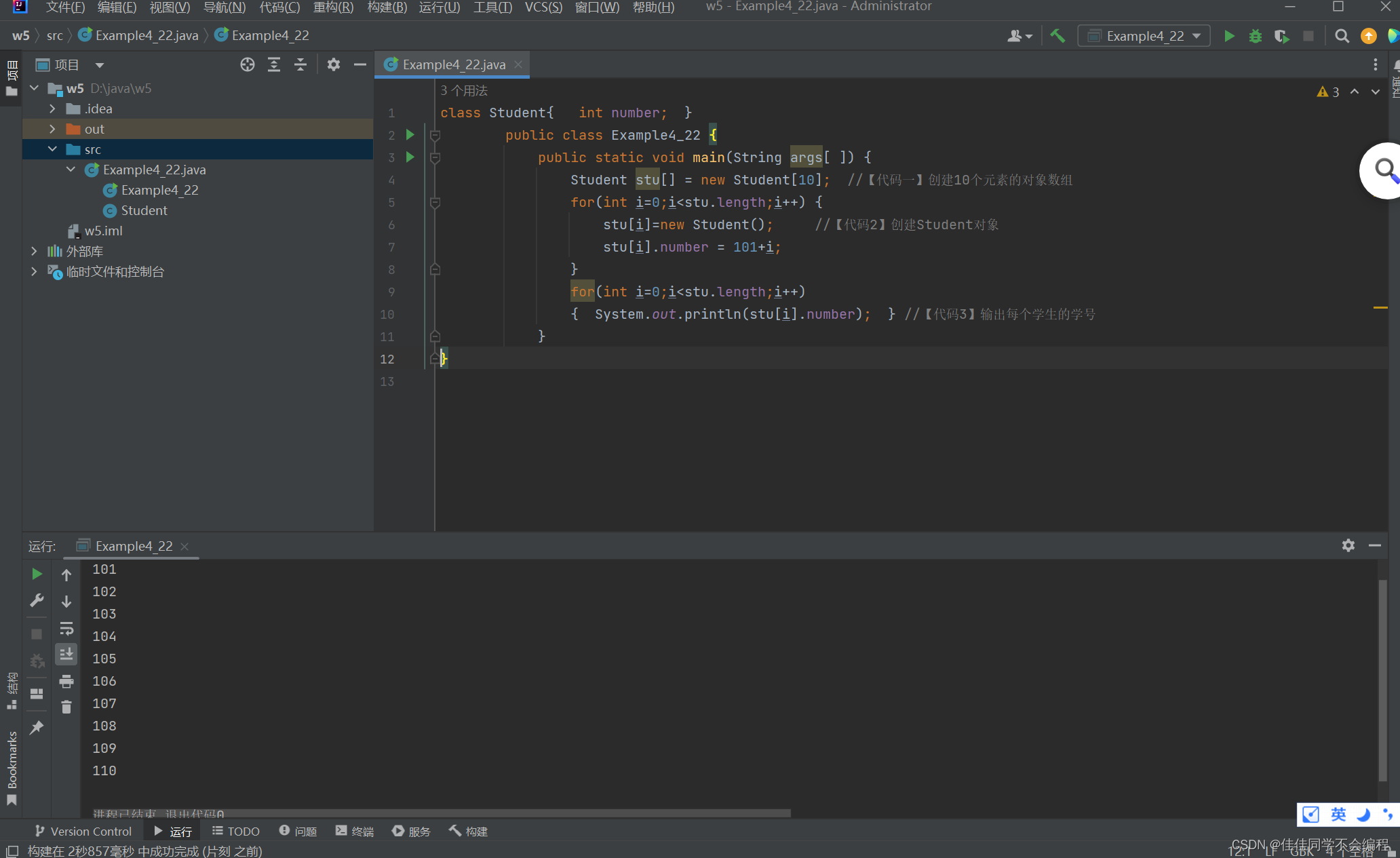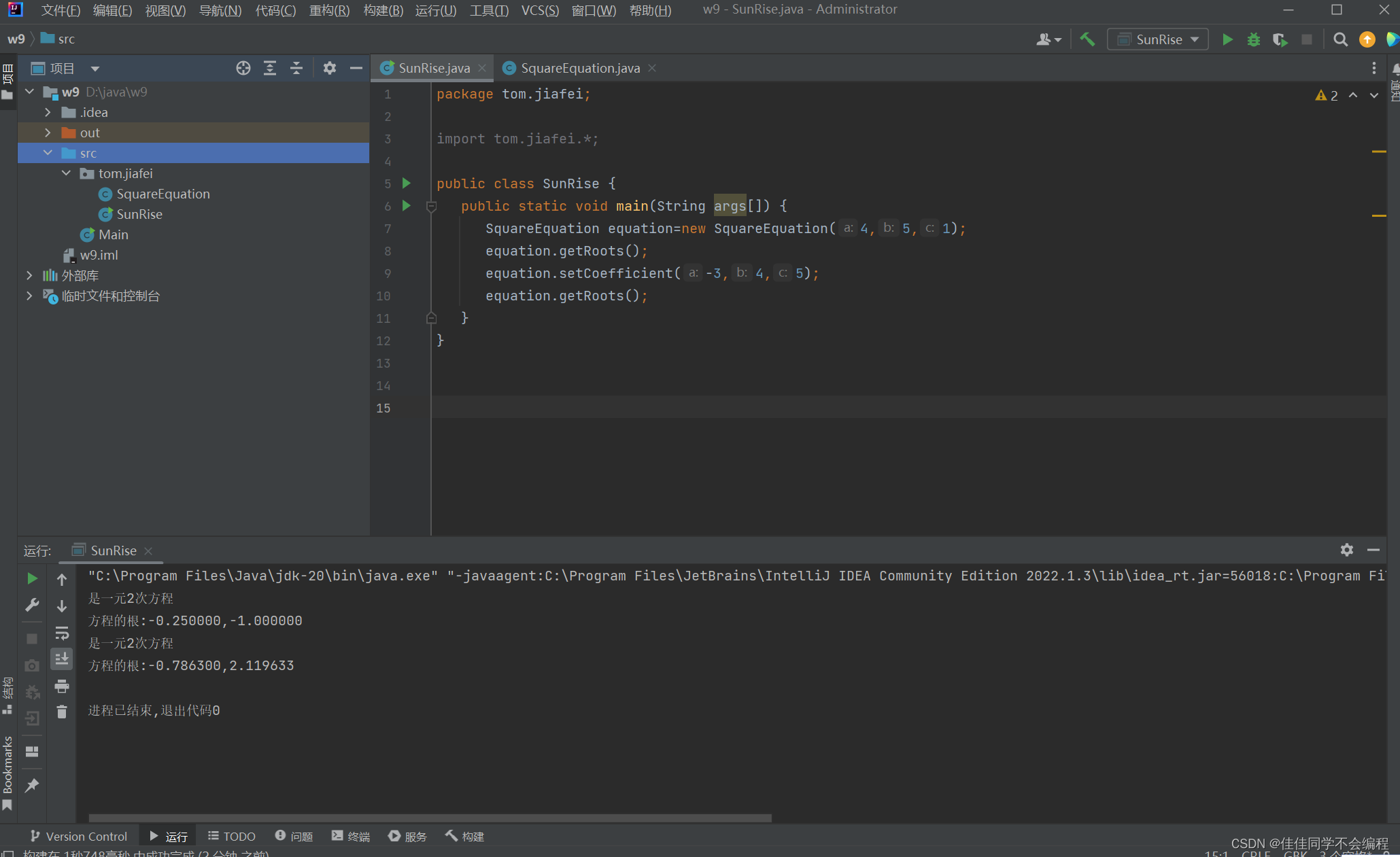1.例子10中的Lader.java中的Lader类创建的梯形对象共享一个下底。
public class Lader {
static double above;
double height; //实例变量
static double bottom; //定义类变量
void setabove(double a)
{ above = a; }
void setbottom(double b)
{ bottom = b; }
double getabove()
{ return above; }
static double getbottom() //定义类方法getbottom
{ System.out.println("上底:"+above); //能否访问实例成员变量above
return bottom;
public static void main(String args[]) {
System.out.println("下底:"+Lader.getbottom()); //用lader类调用getbottom方法
Lader.bottom=100; //给类变量bottom赋值
Lader lad1=new Lader();
Lader lad2=new Lader();
lad1.setabove(28);
lad2.setbottom(66);
System.out.println("lad1上底:"+lad1.getabove());
System.out.println("lad1下底:"+lad1.getbottom());
System.out.println("lad2上底:"+lad2.getabove());
System.out.println("lad2下底:"+lad2.getbottom());
}
}
运行结果:

【代码3】不能在静态方法中访问实例成员变量above,
- 修改上题:定义Lader类变量num,用于计数创建的对象个数
定义静态变量num,并定义构造方法实现num++
public class Lader {
static double above;
double height; //实例变量
static double bottom;//定义类变量
static int num;
Lader() {
num++;
}
void setabove(double a) {
above = a;
}
void setbottom(double b) {
bottom = b;
}
double getabove() {
return above;
}
static double getbottom() //定义类方法getbottom
{
System.out.println("上底:" + above); //【代码3】能否访问类成员变量above
return bottom;
}
public static void main(String args[]) {
System.out.println("下底:" + Lader.getbottom()); //用lader类调用getbottom方法
Lader.bottom = 100; //给类变量bottom赋值
Lader lad1 = new Lader();
Lader lad2 = new Lader();
lad1.setabove(28);
lad2.setbottom(66);
System.out.println("lad1上底:" + lad1.getabove());
System.out.println("lad1下底:" + lad1.getbottom());
System.out.println("lad2上底:" + lad2.getabove());
System.out.println("num:" +lad2.num);
}
}

3.基本类型的类封装
Double(double num) Float(float num) Byte(byte num) Short(short num)
Integer(int num) Long(long num)
对象.类型Value() 取对象内的值
public class Main {
public static void main(String[] args) {
String s1="20.4";
String s2="80.7";
System.out.println(s1+s2);
Double d1=new Double(s1);//Double d1=20.5;
Double d2=new Double(s2);
double m1=d1.doubleValue();//Double.parseDouble(s1);
double m2=d2.doubleValue();
System.out.println(m1);
System.out.println(m2);
}
}

4.CHARACTER 类:判断是数字还是字母,是字母的话小写的转换成大写,大写的转换成小写。
public class Main {
public static void main(String args[]) {
String a="+4cDbF6*";
String s1="",s2="",s3="",s4="";
for(int i=0;i<a.length();i++) {
char ch=a.charAt(i);
if(Character.isDigit (ch)) //该字符如果是数字
s1=s1+ch;
else if(Character.isLetter(ch)) //该字符如果是字母
if(Character.isUpperCase(ch)); //该字符如果是大写字母 s2=s2+Character.toLowerCase(ch);
else s3=s3+Character.toUpperCase(ch);
else s4=s4+ch;
}
System.out.println("数字:"+s1);
System.out.println("to Lower Case:"+s2);
System.out.println("to Upper Case:"+s3 );
System.out.println("Others:"+s4);
}
}

- 例22使用对象数组
class Student{ int number; }
public class Example4_22 {
public static void main(String args[ ]) {
Student stu[] = new Student[10]; //创建10个元素的对象数组
for(int i=0;i<stu.length;i++) {
stu[i]=new Student(); //创建Student对象
stu[i].number = 101+i;
}
for(int i=0;i<stu.length;i++)
{ System.out.println(stu[i].number); } //输出每个学生的学号
}
}

新实践四
实验一:
public class Vehicle {
double speed;//声明double型变量speed,刻画速度
int power;//声明int型变量power,刻画功率
void speedUp(int s) {
speed=speed+s;
//将参数s的值与成员变量speed的和赋值给成员变量speed
}
void speedDown(int d) {
speed=speed-d; //将成员变量speed与参数d的差赋值给成员变量speed
}
void setPower(int p) {
power=p; //将参数p的值赋值给成员变量power
}
int getPower() {
return power; //返回成员变量power的值
}
double getSpeed() {
return speed;
}
}
public class User {
public static void main(String args[]) {
Vehicle car1,car2;
car1=new Vehicle(); //使用new 运算符和默认的构造方法创建对象car1
car2=new Vehicle(); //使用new 运算符和默认的构造方法创建对象car2
car1.setPower(128);
car2.setPower(76);
System.out.println("car1的功率是:"+car1.getPower());
System.out.println("car2的功率是:"+car2.getPower());
car1.speedUp(80); //car1调用speedUp方法将自己的speed的值增加80
car2.speedUp(80); //car2调用speedUp方法将自己的speed的值增加80
System.out.println("car1目前的速度:"+car1.getSpeed());
System.out.println("car2目前的速度:"+car2.getSpeed());
car1.speedDown(10);
car2.speedDown(20);
System.out.println("car1目前的速度:"+car1.getSpeed());
System.out.println("car2目前的速度:"+car2.getSpeed());
}
}
运行结果:

实验二:
public class TV {
int channel; //电视频道
void setChannel(int m) {
if(m>=1){
channel=m;
}
}
int getChannel(){
return channel;
}
void showProgram(){
switch(channel) {
case 1 : System.out.println("综合频道");
break;
case 2 : System.out.println("经济频道");
break;
case 3 : System.out.println("文艺频道");
break;
case 4 : System.out.println("国际频道");
break;
case 5 : System.out.println("体育频道");
break;
default : System.out.println("不能收看"+channel+"频道");
}
}
}
public class Family {
TV homeTV;
void buyTV(TV tv) {
homeTV=tv; //将参数tv赋值给homeTV
}
void remoteControl(int m) {
homeTV.setChannel(m);
}
void seeTV() {
homeTV.showProgram(); //homeTV调用showProgram()方法
}
}
public class MainClass {
public static void main(String args[]) {
TV haierTV = new TV();
haierTV.setChannel(5); //haierTV调用setChannel(int m),并向参数m传递5
System.out.println("haierTV的频道是"+haierTV.getChannel());
Family zhangSanFamily = new Family();
zhangSanFamily.buyTV(haierTV);
//zhangSanFamily调用void buyTV(TV tv)方法,并将haierTV传递给参数TV
System.out.println("zhangSanFamily开始看电视节目");
zhangSanFamily.seeTV();
int m=2;
System.out.println("hangSanFamily将电视更换到"+m+"频道");
zhangSanFamily.remoteControl(m);
System.out.println("haierTV的频道是"+haierTV.getChannel());
System.out.println("hangSanFamily再看电视节目");
zhangSanFamily.seeTV();
}
}
运行结果:

实验三:
public class Village {
static int waterAmount; //模拟水井的水量
int peopleNumber; //村庄的人数
String name; //村庄的名字
Village(String s) {
name = s;
}
static void setWaterAmount(int m) {
if(m>0)
waterAmount = m;
}
void drinkWater(int n){
if( waterAmount-n>=0) {
waterAmount = waterAmount-n;
System.out.println(name+"喝了"+n+"升水");
}
else
waterAmount = 0;
}
static int lookWaterAmount() {
return waterAmount;
}
void setPeopleNumber(int n) {
peopleNumber = n;
}
int getPeopleNumber() {
return peopleNumber;
}
}
public class Land {
public static void main(String args[]) {
Village.setWaterAmount(200); //用类名调用setWaterAmount(int m),并向参数传值200
int leftWater =Village.waterAmount; //用Village类的类名访问waterAmount
System.out.println("水井中有 "+leftWater+" 升水");
Village zhaoZhuang,maJiaHeZhi;
zhaoZhuang = new Village("赵庄");
maJiaHeZhi = new Village("马家河子");
zhaoZhuang.setPeopleNumber(80);
maJiaHeZhi.setPeopleNumber(120);
zhaoZhuang.drinkWater(50);//zhaoZhuang调用drinkWater(int n),并向参数传值50
leftWater = maJiaHeZhi.lookWaterAmount();//maJiaHeZhi调用lookWaterAmount()方法
String name=maJiaHeZhi.name;
System.out.println(name+"发现水井中有 "+leftWater+" 升水");
maJiaHeZhi.drinkWater(100);
leftWater = zhaoZhuang.lookWaterAmount();//zhaoZhuang调用lookWaterAmount()方法
name=zhaoZhuang.name;
System.out.println(name+"发现水井中有 "+leftWater+" 升水");
int peopleNumber = zhaoZhuang.getPeopleNumber();
System.out.println("赵庄的人口:"+peopleNumber);
peopleNumber = maJiaHeZhi.getPeopleNumber();
System.out.println("马家河子的人口:"+peopleNumber);
}
}
运行结果:

实验四:
public class SquareEquation {
double a,b,c;
double root1,root2;
boolean boo;
public SquareEquation(double a,double b,double c) {
this.a=a;
this.b=b;
this.c=c;
if(a!=0)
boo=true;
else
boo=false;
}
public void getRoots() {
if(boo) {
System.out.println("是一元2次方程");
double disk=b*b-4*a*c;
if(disk>=0) {
root1=(-b+Math.sqrt(disk))/(2*a);
root2=(-b-Math.sqrt(disk))/(2*a);
System.out.printf("方程的根:%f,%f\n",root1,root2);
}
else {
System.out.printf("方程没有实根\n");
}
}
else {
System.out.println("不是一元2次方程");
}
}
public void setCoefficient(double a,double b,double c) {
this.a=a;
this.b=b;
this.c=c;
if(a!=0)
boo=true;
else
boo=false;
}
}
package tom.jiafei;
import tom.jiafei.*;
public class SunRise {
public static void main(String args[]) {
SquareEquation equation=new SquareEquation(4,5,1);
equation.getRoots();
equation.setCoefficient(-3,4,5);
equation.getRoots();
}
}
运行结果:























 4959
4959

 被折叠的 条评论
为什么被折叠?
被折叠的 条评论
为什么被折叠?








